
Have you planned your company Digital Journey?
SAP has been changing their plans regarding the future of their HCM product according to the market’s demands and their intentions to move towards new technologies.
As an SAP Consultant and Service Delivery Manager, I have been asked different questions by many clients regarding this matter. They all want to know what the intentions of SAP in the near future are and how this will impact their current solution. I noticed some confusion and uncertainty around it. Therefore, I decided to investigate more and gather all the important information in one place. The aim of this blog is to simplify and give some clarity on the SAP strategy.
Clarifications before making any decision for your company’s next move…
To start, I would like to share some definitions that will help understand the different solutions and what might be required for your company’s next move. I would like to concentrate on SAP HCM products.
SAP ECC (also called SAP ERP)

It is the core ERP product within SAP Business Suite. SAP ECC can run in all existing databases except HANA (i.e.: Oracle), whereas S/4HANA can only run on HANA.
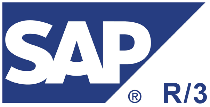
SAP R/3

R/3 is SAP ECC's predecessor and equivalent. It uses the client-server model and allows users to store, retrieve, analyze, and process corporate data. R3 stands for 3 tiers system: Database, Application & Presentation. This makes it time consuming for large reports compared to SAP HANA that retrieves data directly from application layer to the presentation layer as it uses in-memory technology. R3 needs to fetch data from disk, while SAP HANA reads it straight from RAM.

SAP HANA (High-performance ANalytic Appliance)

It is an application that uses in-memory database technology that allows the processing of massive amounts of real-time data in a short time. The in-memory computing engine allows HANA to process data stored in RAM as opposed to reading it from a disk. SAP HANA can run on any cloud or on-premise solution.

SAP S/4HANA (fourth version of SAP Business Suite, designed to run only on SAP HANA)

It is an ERP business suite based on the SAP HANA in-memory database that allows companies to perform transactions and analyze business data in real-time. SAP S/4HANA is the next-generation successor to the SAP Business Suite ERP platform. It is intended to be easier to use and administer, helping to solve complex problems and handle larger amounts of data than its predecessors.
While SAP strongly pushes its customers toward the cloud option, it is available in deployment models:
- On-premise
- Cloud
- Hybrid
SAP S/4 HANA uses SAP Fiori as its front end (UI) technology.
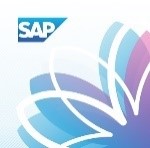
SAP Fiori (“flowers” in Italian)

SAP Fiori is a new user experience (UX) for SAP software and applications. It provides a set of applications that are used in regular business functions such as work approvals, financial apps, calculation apps and various self-service apps. SAP Fiori is driving the evolution of user interface, which is why SAP emphasize its use for the next-generation S/4HANA applications.
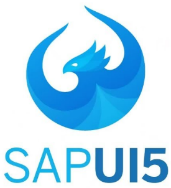
SAPUI5

While Fiori is a design concept, SAPUI5 is a framework that includes a collection of libraries that can be used to build applications that run in a desktop or mobile browser. Fiori applications are those that adhere to Fiori design guidelines. The ones that do not follow those guidelines are custom UI5 apps.

SAP SuccessFactors

SAP SuccessFactors is a cloud-based HR solution. This business solution is based on Software as a Service (SaaS) model. The tool is designed to meet the requirement of enterprise-class organizations. The company breaks out its talent tools into modules in its SAP SuccessFactors HCM Suite. Capabilities include the traditional "four pillars" of talent management:
- Recruiting,
- Learning and development,
- Performance management and
- Compensation management.
The suite also includes:
- Onboarding,
- Time and Attendance software,
- Workforce planning and
- People analytics.
To migrate or not to migrate? That is the question!
Eventually, all companies will have to migrate to SAP S/4HANA or SAP SuccessFactors.
The question is when, how and how much will it cost?
Here is a summary of the current situation based on the latest released news by SAP. In other words, the following article describes the extension of the SAP Timeline Support, and what they call: the “offboarding phase” (making reference to the migration from SAP Business Suite 7 to SAP S/4HANA).
On February 2020, SAP announced some changes to their commitment to mainstream maintenance support for their SAP ERP HCM customers (SAP Business Suite 7 software) and for SAP S/4HANA. Below is the formal SAP announcement:
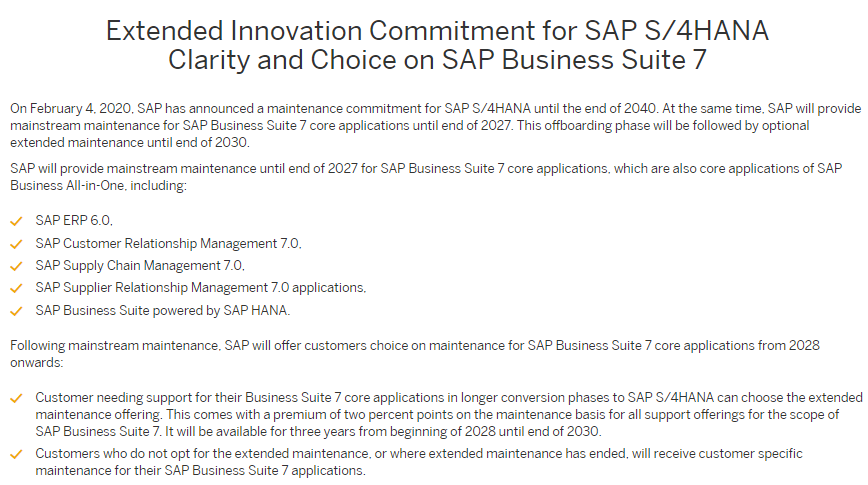
In a few words, SAP ERP HCM for SAP S/4HANA on-premise will only be available in 2022.
From 2022 until 2027 SAP will continue providing support to SAP Business Suite 7 core applications. And from 2028 to 2030, customers can choose an optional extended maintenance for a 2% premium.
The following graphic shows the different migration options and the transition window.
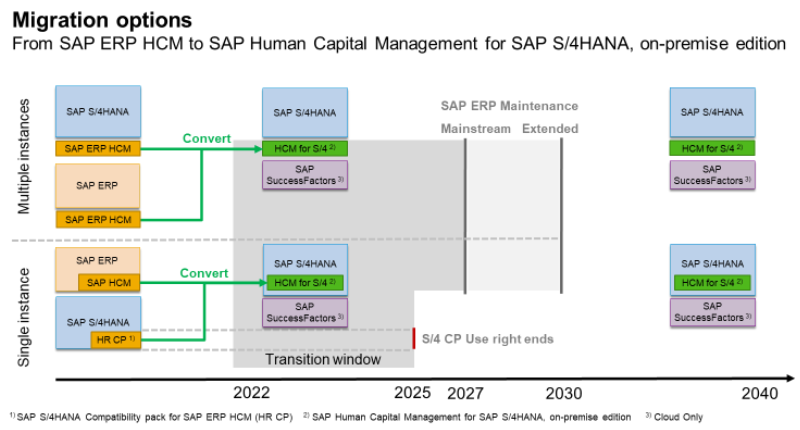
It is time for a change. What is the SAP investment direction?
SAP encourages all customers to move towards SuccessFactors to accelerate their digital HR transformation. However, they are still investing in innovation on both fronts: SAP ERP HCM and SAP SuccessFactors. And in regard to the mobile strategy, SAP puts the focus on SAP Fiori apps for employees and managers. The focus of innovation for on-premise has to do with user experience leveraging Fiori.
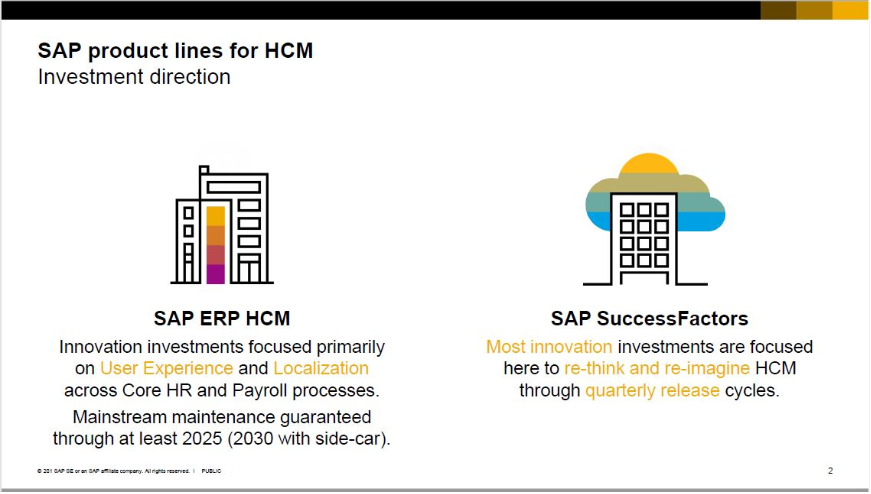
This means that SAP is still investing and dedicating resources in both areas to support them and also improve them. There is a large number of companies that are not yet ready to move to a cloud solution.
Personally, I think it’s time to dig in the new technologies that SAP offers, based on the current solution of each organization. SAP S/4HANA could be an excellent option for clients that do not want to migrate their current system to SuccessFactors, as it offers a great performance for large amounts of data processing. Furthermore, as mentioned before, it could work for on-premises, cloud, or hybrid models.
Ask yourself a few questions before taking the plunge
To summarize, SAP HANA database, S/4HANA business suite and SAP Fiori as the UX for the user interface are the 3 main focus of SAP for clients that are not ready to migrate to SAP SuccessFactors. Furthermore, the “offboarding phase” will be extended with mainstream maintenance for SAP Business Suite 7 for at least 10 years from now (until 2027 plus 3 more years with a supplementary fee). This gives more time to companies that are not ready to make the move, to analyze their current situation and plan their “digital journey”.
Now, do you think your company needs a change?
Is it ready to do a migration?
What is the current technological and economic situation of your company?
Do you count with the right resources to go through this process?
These are some of the questions that you should consider before deciding to change the technological course of your company.
IN-RGY counts with a multidisciplinary team of certified solution architects who deliver HR solutions that meet your needs. Please do not hesitate to contact us if you have any questions or if you need technical advice.
Daniela Gangemi
Delivery Manager
SAP SuccessFactors
REFERENCES
- SAP ERP Human Capital Management Road Map: https://blog.asug.com/hubfs/ASUG82652%20-%20Road%20Map%20SAP%20ERP%20Human%20Capital%20Management%20(Focus%20SAP%20Fiori).pdf
- SAP to Build New SAP S/4HANA Sidecar On-Premise HCM Product (ASUG news): https://www.asug.com/news/sap-to-build-new-sap-s-4hana-sidecar-on-premise-hcm-product
- Note 2881788 - End of SAP Business Suite 7 mainstream maintenance: https://launchpad.support.sap.com/#/notes/2881788
- SAP Extends Its Innovation Commitment for SAP S/4HANA, Provides Clarity and Choice on SAP Business Suite 7: https://news.sap.com/2020/02/sap-s4hana-maintenance-2040-clarity-choice-sap-business-suite-7/
- Extended Innovation Commitment for SAP S/4HANA Clarity and Choice on SAP Business Suite 7: https://support.sap.com/en/release-upgrade-maintenance/maintenance-information/maintenance-strategy/s4hana-business-suite7.html
- From SAP ERP 6.0 to SAP S/4HANA in Four Steps: https://news.sap.com/2016/08/from-sap-erp-6-0-to-sap-s4hana-in-four-steps/

